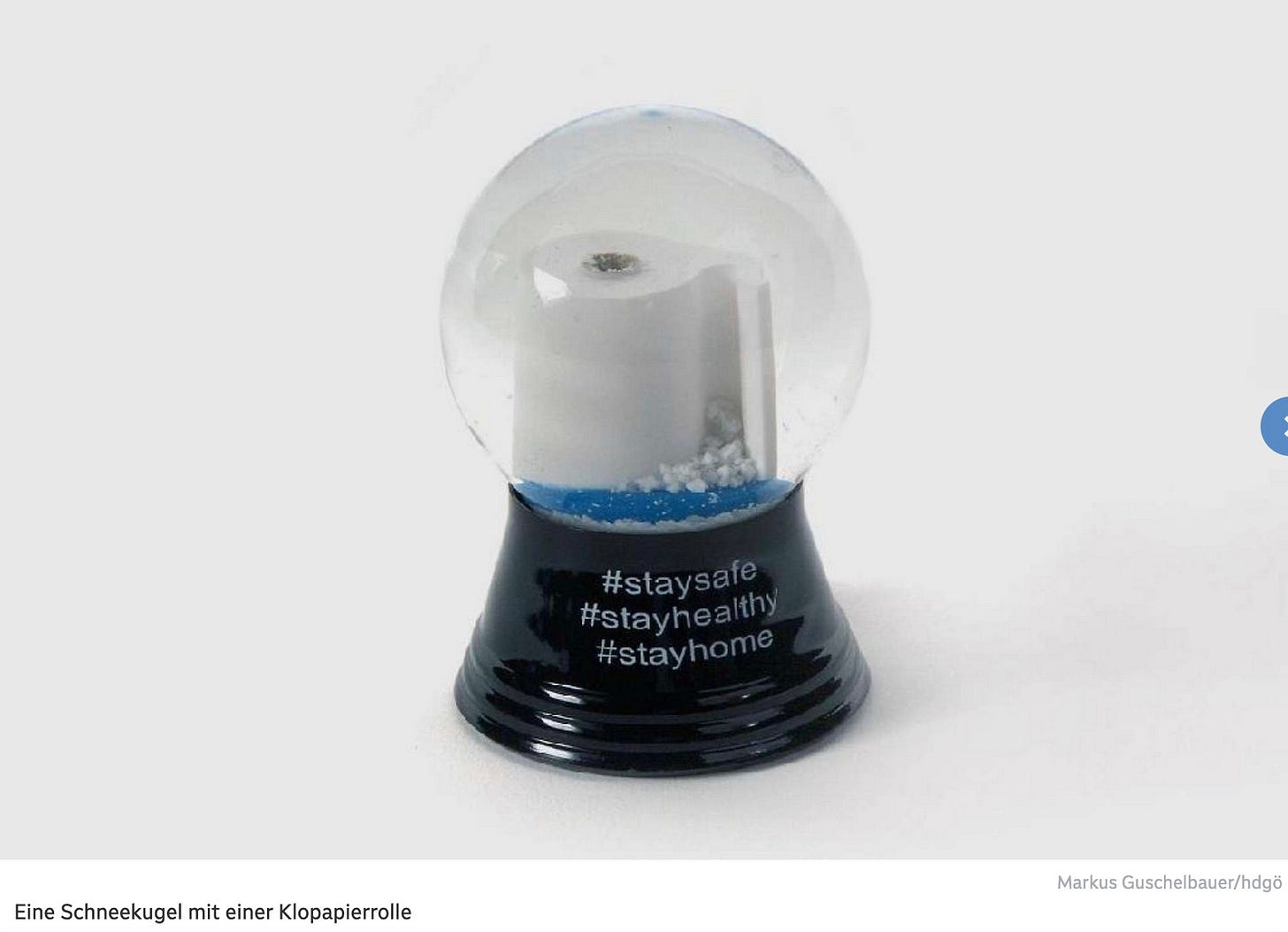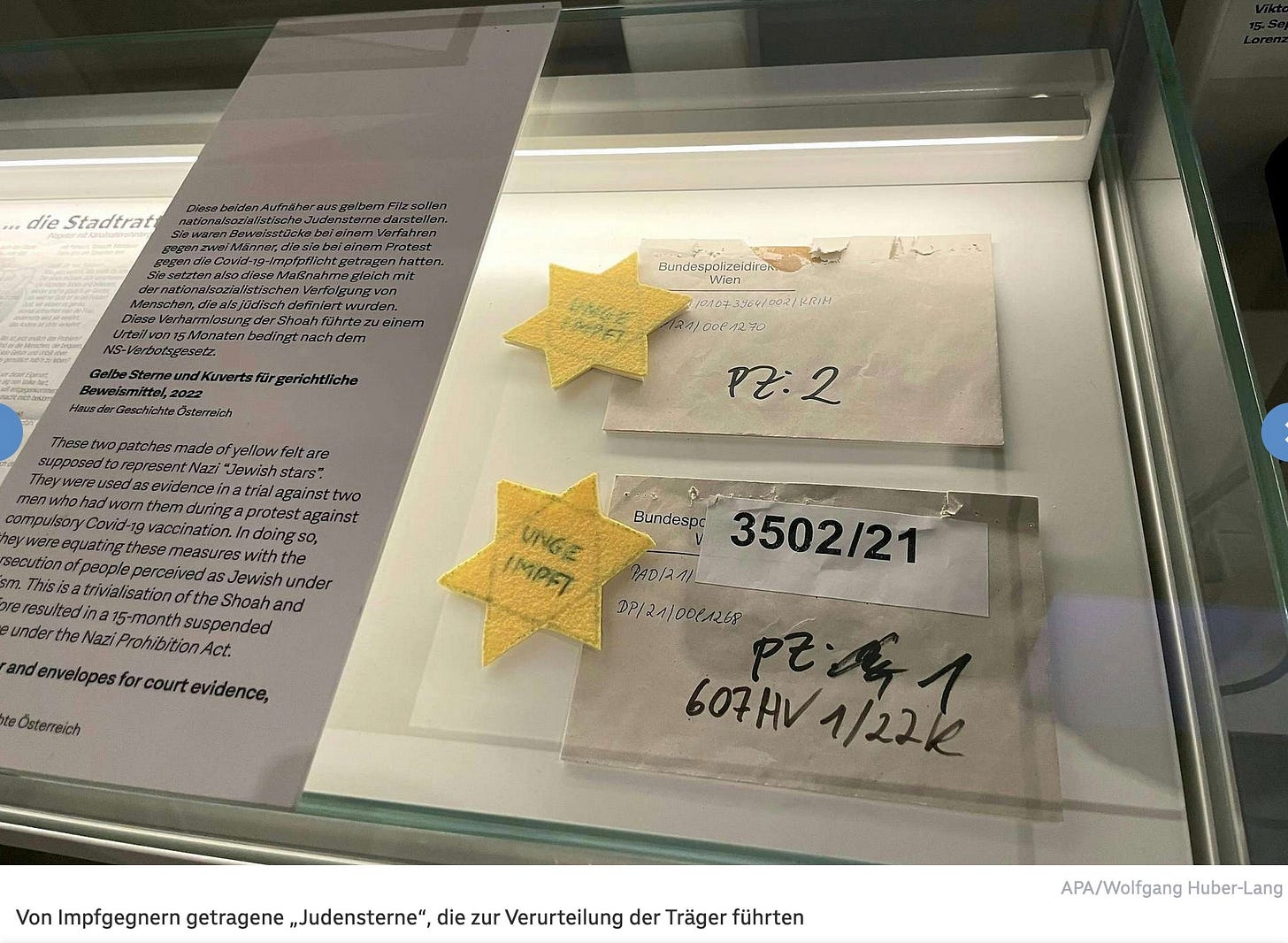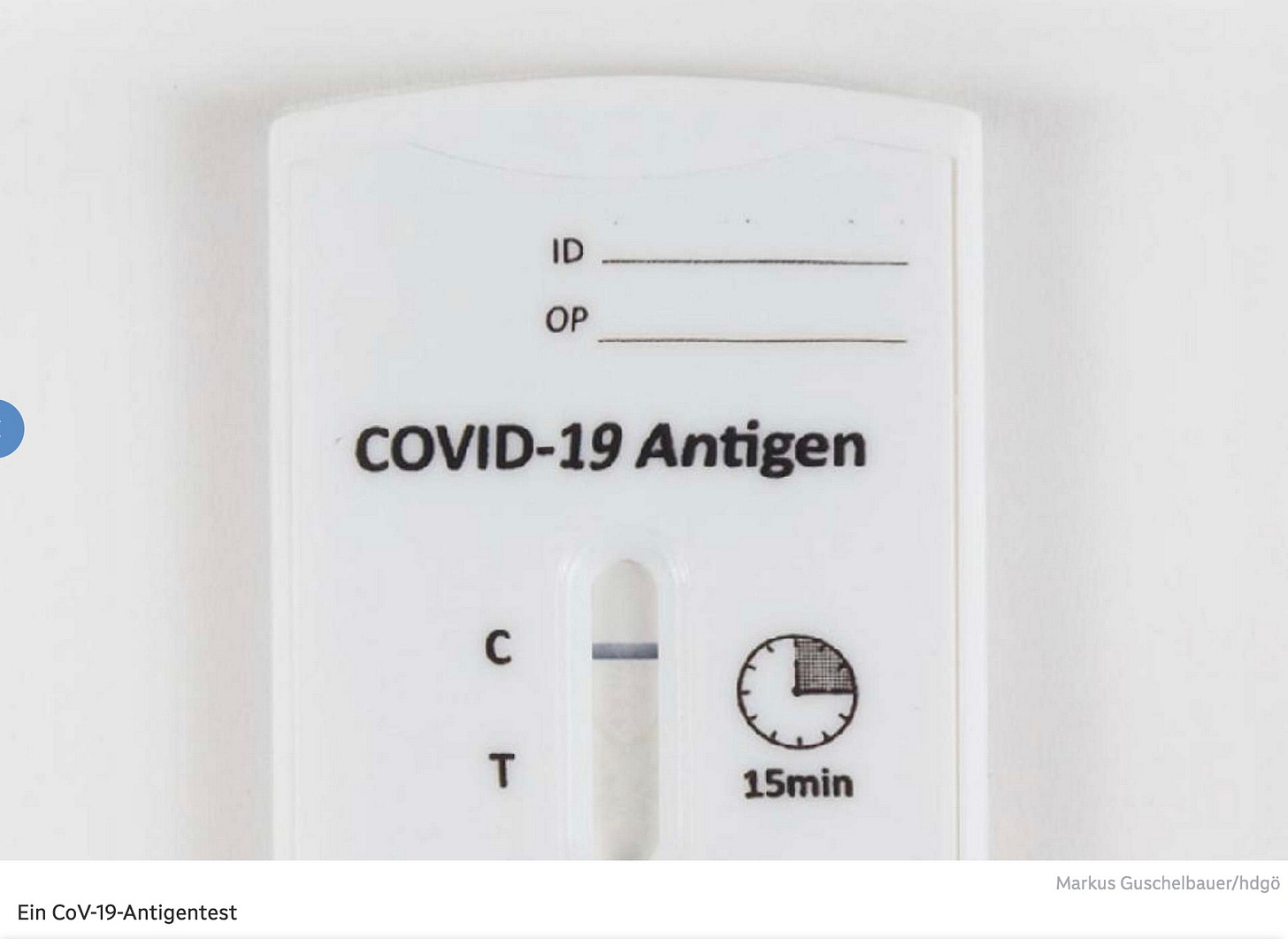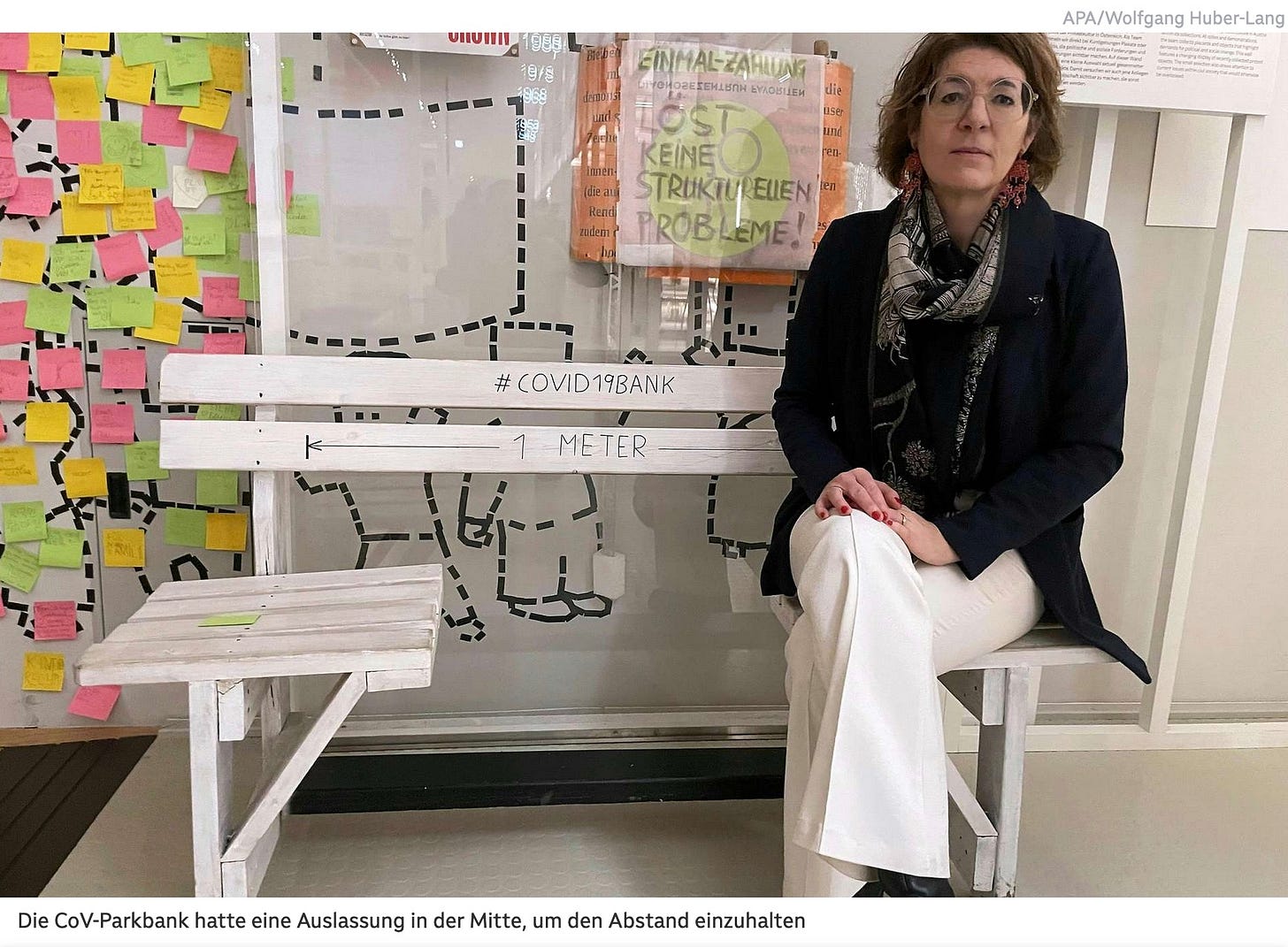'Toilet Paper Rolls and a Park Bench: Covid in the Museum'
As legacy media rolls out the Covid Reckoning 2.0, telling puff pieces are discussing™ the WHO-declared, so-called 'Pandemic™', with Austro-Covidian state broadcaster firing the next shot
Last week, we looked at what I thought of as the opening parts of the next stage of the ‘Covid Reckoning’, specifically the absurd and highly misleading ‘Not everything was bad’ Der Spiegel editorial by Branch Covidian-masquerading-as-journo™ Claus Hecking:
Not to be outdone, this week Austro-Covidian state broadcaster is following up on this kind of reporting™ with a special feature by the no-less Branch Covidian journos™ over at ORF Vienna.
If, at this point, you’re still marvelling at the apparent madness of legacy media journos™, well, I’m sure you’ll ‘enjoy’ their reminiscences reproduced below. (As always, translation, emphases, and [snark] mine.)
Today’s piece is both about the subject outlined above—as well as a documentation of how the process of ‘reification’—as envisioned by Hungarian Bolshevik George Lukács—works in praxis (pun intended).
Here is a primer from the Museum of the City of Vienna’s announcement:
On 25 March 2020, shortly after the start of the first coronavirus lockdown in Austria, the Wien Museum was the first museum in Austria to launch a call for collections on the pandemic and asked the Viennese population for information on objects that tell of the changes in everyday private and professional life in times of Covid-19. At the same time, the Wien Museum launched photo projects to document the city in a state of emergency and began actively collecting objects itself.
By November 2020, the Wien Museum had received more than 3,000 messages with object and photo suggestions. By 2022, a total of around 500 objects and photographs had been added to the Wien Museum’s collection and recorded together with the personal memories of the object donors and comprehensive contextual information. The collected objects and photographs tell of a wide range of topics: from the reorganisation of everyday life between home office and home schooling, from the personal and social handling of illness, hygiene and physical distancing, from creative forms of crisis management and new forms of solidarity and neighbourhood help, but also from new areas of social conflict that opened up in the course of the pandemic.
Toilet Paper Rolls and a Park Bench: Covid in the Museum
Via wien.ORF.at, 2 Feb. 2025 [source]
The Coronavirus Pandemic has left its mark: in collective memory, in linguistic usage, and now also in Vienna’s museums. The House of Austrian History and the Wien Museum began expanding their collections relating to the pandemic at an early stage.
In the current exhibition at the Haus der Geschichte Österreich (hdgö [House of Austrian History; do click on their online collection and marvel at the items they display]), you come across the Coronavirus in a surprising place: in the anti-Semitism section [and do remember that any inferences or, worse, comparisons, are, of course, evil™ and akin to Holocaust denial]. There are two yellow felt stars in a display case. Instead of ‘Jew’ as in the Nazi era, they are labelled ‘Unvaccinated’. They are pieces of evidence in a trial in which opponents of compulsory vaccination were found guilty of trivialising the Shoah in 2022. The envelopes from the police seizure are displayed next to it [see the photograph of this exhibit below].
[note that the piece is illustrated with the following images, which I’m reproducing to convey the special ‘flavour’ of both the reporting™ and, of course, to provide as authentic an impression as possible of the exhibition]
A snow ball with a toilet paper roll [I’m unsure what this should symbolise other than utter stupidity and the massive gaslighting; also: really?!].
‘Jewish badges’ worn by antivaxxers, which led to the sentencing of those who wore them [note the English caption on the left-hand side].
The Großglockner [Austria’s highest mountain peak] without contrails [presumably, there are contrails visible, I suppose, but none of my quick images search with DuckDuckGo or Google Search shows much, if any evidence of them].
Used PPE after a test [gee, I hope this thing was thoroughly decontaminated before being put on display; also: extra-gross]
Textbooks with Covid Laws [we note, in passing, the unconstitutionality of some of the ordinances and regulations pushed by Chancellor Sebastian Kurz in spring and summer 2020; these were so shoddily done that, when asked about it in a press briefing in spring 2020, Mr. Kurz noted that ‘these ordinances would no longer be in force once the Constitutional Court would assemble at a later point to discuss their constitutionality’—this was so embarrassing that ‘even’ legacy media outlets such as the Süddeutsche Zeitung and Die Zeit (entirely pro-mandate outlets) noted this; of course, this—shall we say ‘problematic’—understanding of the constitution was also discussed by the Neue Zürcher Zeitung back then on 9 May 2020 (do note that the header was apparently changed at a later time as the URL, which cannot be changed that easily, reads as follows:
https://www.nzz.ch/international/sebastian-kurz-zeigt-in-der-corona-krise-autoritaere-zuege-ld.1792115
Consider my translation of the URL—‘Sebastian Kurz displays an authoritarian personality in the Covid crisis’—with the header ‘Look at me: how Sebastian Kurz is doing in the pandemic’ even though the website doesn’t indicate later editorialising]
A Cov-19 lateral flow test [sic; just in case you’re suffering from nostalgia about a period when ‘not everything was bad’, as Claus Hecking wrote]
Between Covid Park Bench and Camouflage Suit
With a white-painted ‘Covid19 bench’, on which the removal of the middle section of the seat ensured that the required safety distance of one metre was maintained [no need to mention the utter lack of any evidence for that ‘required safety (sic) distance; see also the picture below, if you cannot believe this BS], only a second of the 120 or so objects in the museum’s collection relating to Covid is currently on display. The first item to be added to the collection was a roll of toilet paper reminiscent of the hoarding purchases made during the first lockdown, while the last item to go into storage was General Rudolf Striedinger’s camouflage suit [Gen. Striedinger co-chaired the civil-military taskforce and typically attended wearing combat fatigues (but often no mask)], which has become a cult favourite [there is no irony in the reporting™] thanks to his media appearances as head of the Governmental Covid Crisis Coordination Commission (GECKO Commission).
‘We immediately launched an appeal on the internet and soon put a web exhibition on corona online’, recalls hdgö Director Monika Sommer in an interview with the Austrian Press Agency (APA), explaining:
Museums used to wait 30 years to gain historical distance. That has changed radically. Today, collections are made internationally under the term ‘Rapid Response Collecting’ to keep up with the times. Of course, you have to make sure that you don’t accumulate everything. It also helps that museums today are increasingly daring to remove objects once they have been documented [is it too absurd to cite George Orwell’s 1984 here? I think it’s more than appropriate to do so: ‘Every record has been destroyed or falsified, every book rewritten, every picture has been repainted, every statue and street building has been renamed, every date has been altered. And the process is continuing day by day and minute by minute. History has stopped. Nothing exists except an endless present in which the Party is always right.’
This Cov Park Bench is missing its middle part to make you keep your distance [nevermind the absence of any evidence whatsoever that ‘6ft distance’—invented by Dr. Fauci—actually did anything to prevent the spread, esp. outdoors]
Covid Dictionary at the Wien Museum
Some objects from the Wien Museum’s coronavirus collection even made it into an article in the British Guardian in 2021, which documented the relevant collection efforts of museums around the world [no link provided in the original, but I think it is this piece by Stephen Moss dated 21 Feb. 2021].
These included a handwritten Covid dictionary, which a Ukrainian woman used to teach herself new German terms such as curfew, social distancing, and compulsory masks [again, a helpful quote from Orwell’s 1984: ‘Power is in tearing human minds to pieces and putting them together again in new shapes of your own choosing.’], a coronavirus item crocheted from green yarn, which was intended to take the fear out of the pandemic and is reminiscent of the various manual labour performed during the lockdown, and an original Viennese snow globe [see that above picture], which was launched on the market in spring 2020 by the fast-responding company in a version with a mini plastic toilet roll [art imitates life, isn’t it? /sarcasm].
Online Collection Appeals Launched Early
Like the hdgö and the Graz Museum, the Wien Museum also launched a web appeal on 25 March 2020, making it ‘the first museum in Austria and perhaps even in Europe’, reports curator Martina Nußbaumer. Over 3,000 emails with around 8,000 attached photos were the result. ‘People saw it like an internet challenge. And they clearly felt the need to communicate about this exceptional situation.’ They also started their own photo projects to document the changed cityscape.
Activities that were also due to the realisation: ‘There is almost nothing from past pandemics in our collections.’ [huhum, perhaps past ‘pandemics’ were not as hyped and stage-managed (‘flood the zone’, in CIA speak) like this one?]
The Wien Museum’s collection also includes a hand-written CoV Dictionary [careful, this is fake news as a listing of composite nouns—also, done in the most simplistic way by simply adding the word ‘Corona’ to whatever noun is listed—is just that: a list (for dictionaries typically contain explanations)]
Nußbaumer estimates the Wien Museum’s coronavirus collection at around 500 objects and photographs. They tell of working from home and home schooling, of solidarity and neighbourly help, but also of new social conflicts. Here, too, the necessary [sic] restrictions soon became an important issue:
We soon had to limit ourselves when it came to collecting masks, even though transformation processes in particular can be told through the type of masks, from the self-tailored ones to the FFP2 models. [we note, in passing, that none of the masks mentioned here work, and at this point I’d like to remind everyone of the utter madness the mask fetish of esp. the Vienna State Gov’t (Landesregierung) who clung to mask mandates until well the surrounding state of Lower Austria had stopped them]
Too Emotionalised for Real Exhibitions
The online exhibitions of both museums are dedicated to the topic of coronavirus in separate chapters. There has not yet been a separate, analogue exhibition about the Covid era here [gee, I wonder why…]. Monika Sommer and Martina Nußbaumer agree in their assessment: it’s still too early for that. The topic is still too emotionalised. Some people don’t want to hear any more about it [that would be those who willingly collaborated with the Covid tyrants], others are still too upset [that would include me because I don’t like to be declared illegal by the former Minister for Constitutional Affairs Karoline Edtstadler—because of my injection status].
The next few weeks are likely to be a tough time for both groups, when the first confirmed Covid case in Austria five years ago and its consequences are widely publicised in the media [this is called ‘predictive programming’, isn’t it?].
Bottom Lines: The Never-Ending Shitshow
While I personally don’t understand why the Branch Covidians are still bringing up this most shameful part of their existence (I presume), I am wary enough to offer my explanation for this:
Covid isn’t over in the sense of ‘the Pandemic™’ narrative hasn’t fulfilled all its objectives. What we’re witnessing these days isn’t merely an otherwise inexplicable warming up of these painful and, frankly, infuriating memories.
My sense is that this is done very much on purpose, and I’m inclined to believe that the purpose of this is to make sure that those segments of the population who are wavering in their (tacit) support for the Covid tyrants are reminded that they, too, once stood ‘on the right side of history™’, and that they can return to the Branch Covidians if they chose to do so.
I cannot think of any other reason, except for sheer and utter madness on part of those who consider this perfectly normal.
I mean, look at the web pages by the Wien Museum and the House of Austrian History: not that long ago, museums were places that preserved items of high cultural value that facilitate the forging of collective memories and identities—now, toilet paper rolls, fuzzy phone videos, and, believe it or not, a non-medical grade face diaper with the tagline ‘Black Lives Matter’ serve but one purpose: to extend the agonising death throes of what once were halfway functioning and partially decent Western societies.
So, I hope you ‘enjoy’ watching these clowns finally departing reality-as-is; those who hail and praise these venues—and make no mistake, as the curators told us at the end of the above shitshow, this is what legacy media will do in the coming weeks—work towards the deepening of societal fault lines and to further the sabotage of what remains of our countries.
As such, the Covid shitshow continues, accompanied by the increasingly absurd, yet strangely unidirectional clown car masquerading as journalism™, experts™, and civil society™.
Post Script: Even the Illusions Are Fake
Having read Uwe Tellkamp’s partially autobiographical novel Der Turm (which translates into ‘The Tower’) many years ago—which is set in the late 1980s in the GDR (here’s a link to the German-only Wikipedia entry)—I cannot shake off these allusions to the late-stage Soviet bloc cacophony of stage-managed everything and fake illusions conveyed by politicians, academia, experts, and artists alike Mr. Tellkamp so vividly describes.
It appears more obvious every day that not even (sic) the fake news we’re served several times a day are done carefully enough.
The powers-that-be seem to have stopped caring about whether or not we, the people, see through these shenanigans.
Personally, I prefer the powers-that-be to at least recognise the potential uproar as this at least offers the possibility of them not doing everything that they could do.
These days, it seems we’ve passed that boundary, which indicates we’re in for a wild ride.
Buckle up, this will be a time for the ages.













It’s a sick joke and we’re the punchline and you know they would do it all again given the chance.
If the museum was serious they would bin those exhibits and put on display all the death certificates of the died suddenly’s, the turbo cancer victims, etc.
Maybe include testimonies of all the lives ruined by vaccine injuries?
But that will never happen… they prefer to gaslight and mock us instead.